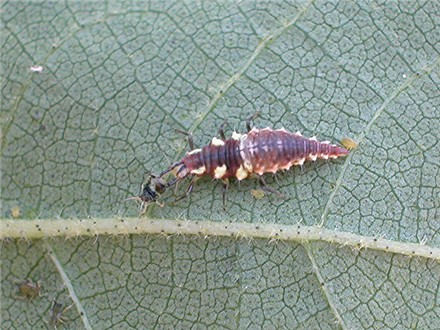LINKS
Lacewings
Blake Layton (Mississippi State University) and Scott Stewart (University of Tennessee), Department of Entomology and Plant Pathology
General Comments:
 Both brown and green lacewings are sometimes common in cotton fields during the summer, especially at times when aphids are, or were, recently numerous. As with lady beetles, these beneficials can aid in controlling budworm/bollworm egg lays that occur after an aphid population has crashed due to an outbreak of the aphid fungus, Neozygites fresenii.
Both brown and green lacewings are sometimes common in cotton fields during the summer, especially at times when aphids are, or were, recently numerous. As with lady beetles, these beneficials can aid in controlling budworm/bollworm egg lays that occur after an aphid population has crashed due to an outbreak of the aphid fungus, Neozygites fresenii.
Description:
Adult green lacewings, including several green-colored species, are slender green insects with golden eyes, long antennae, and large transparent wings. They are about 5/8th of an inch in length. Brown lacewings are similar in general body shape but are smaller and brown in color with wings that are less transparent because they are covered with small brown hairs. The larvae (above) of both brown and green lacewings are similar. They are elongate, “alligator shaped” creatures that taper at both ends and reach a size of about 3/8-inch long. The stout, sickle-like mandibles are easily seen projecting from the front of the head. Larvae are grey to brown in color with yellow markings along the edge of the body. Green lacewings deposit their eggs on a small hair-like stalk, but brown lacewings do not. Both species pupate beneath a thin, transparent webbing. Scouts often encounter lacewing pupae when searching inside bracts of squares, blooms or bolls. The cocoon of the green lacewing is a round, pea-sized structure that is often mistaken for the egg case of a spider. Brown lacewing cocoons are more oval in shape and more loosely woven, so that the developing pupa can be seen through the silk.
Prey:
Larvae of both species feed heavily on aphids and whiteflies, as well as on moth eggs and small caterpillars. They are capable of consuming extremely large numbers of prey when availability is not a limiting factor. In one report from a laboratory study, third instar green lacewing larvae consumed an average of 191 budworm/bollworm eggs or 124 first instar larvae when given free access to prey in a Petri dish. In a study where third instar green lacewing larvae were caged on cotton terminals infested with either 25 eggs or 25 first instar larvae, the lacewings were able to find and consume approximately 75% of the prey within 48 hours. Adults of the brown lacewing are also predatory, but green lacewing adults are not. In fields where aphid populations have crashed and lacewing numbers remain high, their presence and numbers should be considered when making treatment decisions for tobacco budworm and bollworm.







